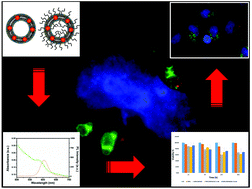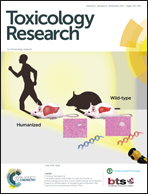Luminescent CdSe@ZnS nanocrystals embedded in liposomes: a cytotoxicity study in HeLa cells
Abstract
The use of fluorescent nanocrystals (NCs) as probes for bioimaging applications has emerged as an advantageous alternative to conventional organic fluorescent dyes. Therefore their toxicological evaluation and intracellular delivery are currently a primary field of research. In this work, hydrophobic and highly fluorescent CdSe@ZnS NCs were encapsulated into the lipid bilayer of liposomes by the micelle-to-vesicle transition (MVT) method. The obtained aqueous NC-liposome suspensions preserved the spectroscopic characteristics of the native NCs. A systematic study of the in vitro toxicological effect on HeLa cells of these red emitting NC-liposomes was then carried out and compared to that of empty liposomes. By using liposomes of different phospholipid composition, we evaluated the effect of the lipid carrier on the cytotoxicity towards HeLa cells. Surprisingly, a cell proliferation and death study along with the MTT test on HeLa cells treated with NC-liposomes have shown that the toxic effects of NCs, at concentrations up to 20 nM, are negligible compared to those of the lipid carrier, especially when this is constituted by the cationic phospholipid DOTAP. In particular, obtained data suggest that DOTAP has a dose- and time-dependent toxic effect on HeLa cells. In contrast, the addition of PEG to the liposomes does not alter significantly the viability of the cells. In addition, the ability of NC-liposomes to penetrate the HeLa cells was assessed by fluorescence and confocal microscopy investigation. Captured images show that NC-liposomes are internalized into cells through the endocytic pathway, enter early endosomes and reach lysosomes in 1 h. Interestingly, red emitting NCs co-localized with endosomes and were positioned at the limiting membrane of the organelles. The overall results suggest that the fluorescent system as a whole, NCs and their carrier, should be considered for the development of fully safe biological applications of CdSe@ZnS NCs, and provide essential indications to define the optimal experimental conditions to use the proposed system as an optical probe for future in vivo experiments.



 Please wait while we load your content...
Please wait while we load your content...